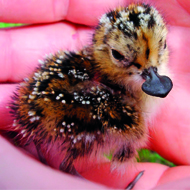
Diverse list represents millions of years of unique evolutionary history.
Experts at Yale University and the Zoological Society of London (ZSL) reveal the world’s 100 most unique and endangered birds in a paper published in Current Biology.
The list was produced by ranking the birds according to how Evolutionary Distinct and Globally Endangered (EDGE) they are.
Scientists assessed numerous species, not only those threatened with extinction, but those highly unique in the way they look, live and behave. These range from the ankle-high sandpiper to the prehistoric-looking greater adjutant, which stands as tall as an adult human.
The northern bald ibis from Morocco is one of the most critically endangered birds listed. This bird suffered a severe population crash following the introduction of pesticides in the 1950s, and it is believed there are less than 300 adult birds remaining in the wild.
The Philippine eagle is another example of a bird becoming ever more endangered. It preys on monkeys and flying lemurs, but despite its strength, it is now under threat from deforestation. It requires an area bigger than the city of Oxford to rear a single chick.
Carly Waterman, EDGE Programme Manager at ZSL, said: “Half of the 100 highest ranked EDGE bird species are receiving little or no conservation attention. We lament the extinction of the dodo, but without action we stand to lose one of its closest relatives, the tooth-billed pigeon or ‘little dodo’, and many other extraordinary birds.
“The release of the EDGE Birds list enables us to prioritise our conservation efforts in the face of a mounting list of endangered species. These one-of-a-kind birds illustrate the incredible diversity that exists in our natural world.”
Image credit: SIMON BUCKELL



 The veterinary mental health charity Vetlife is inviting the veterinary community to join it for a sponsored cold-water dip.
The veterinary mental health charity Vetlife is inviting the veterinary community to join it for a sponsored cold-water dip.